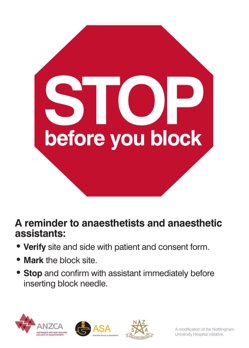Stop Before You Block: A Block Time-Out
The Stop Before You Block (SB4YB) initiative is a patient safety campaign designed to help reduce the risk of inadvertent wrong-sided anaesthetic blocks. Anaesthetists from the Nottingham University Hospital initiated this campaign in 2010 and created the resources to roll it out across the United Kingdom. This creates an additional time-out procedure to reduce the risk of wrong-sided nerve blocks and potentially wrong-sided surgical procedures.

The SB4YB campaign has been endorsed locally by the Australian and New Zealand College of Anaesthetists (ANZCA) and has been incorporated into the PS03 Guideline for the Management of Major Regional Anaesthesia. As the SB4YB patient safety campaign is incorporated into Australian hospitals clinicians will be more likely to encounter this block time-out before peripheral nerve block administration.
The steps involved in SB4YB are an anaesthetic time-out. They include the following:
- Confirming the correct side by visualising the written consent form.
- Asking the patient which side the procedure is to be formed upon (if awake and oriented).
- Visualising the anaesthetic site mark.
These steps in SB4YB should be repeated for each new block site, taking extra care if there is a change in patient position especially patients turned prone, or delay in procedural timing. The SB4YB can be initiated by any member of the anaesthetic team. Some educational tools to implement the SB4YB campaign in your local hospitals can be found at http://www.anzca.edu.au/fellows/safety-and-quality/publications-and-resources.
If you are interested in updating your knowledge and confidence in peri-anaesthesia nursing check out our popular courses for anaesthetic and recovery room nurses. We have courses across Australia in 2020. See our course information below for more details.
- Anaesthesia & Recovery Room Nursing - The Essentials
- Anaesthesia & PACU Nursing
- Anaesthesia & Recovery Nursing in the Day Surgery Environment
References:
Australian and New Zealand College of Anaesthetists (ANZCA) ND, “Stop before you block” guide.
Australian and New Zealand College of Anaesthetists (ANZCA) 2014, PS03 BP: Guidelines for the Management of Major Regional Analgesia Background Paper.
Australian and New Zealand College of Anaesthetists (ANZCA) 2014, PS03 Guidelines for the Management of Major Regional Analgesia.

Crystal Smith is a Senior Education Consultant for Critical Care Education Services (part of the Medcast Group). She has a clinical background in critical care, paediatrics and education.
Become a member and get unlimited access to 100s of hours of premium education.
Learn moreFollow James, a 7-year-old boy scheduled for a tonsillectomy and adenoidectomy, as we explore how the 4 P’s of child preparation – Prepare, Play, Parent, Praise – can be used in day surgery to reduce procedural anxiety, support family-centred care, and improve the overall patient experience
Caregiver concern is a powerful predictor of clinical deterioration in children, often surpassing abnormal vital signs. A recent Lancet study confirms its association with ICU admission and ventilation. Integrating caregiver input into assessments, documentation, and escalation protocols can significantly improve early recognition and outcomes in paediatric emergency care.
Sepsis is a time-critical medical emergency. The National Sepsis Program urges GPs and primary care clinicians to enhance early recognition and management of sepsis to save lives. This update outlines key actions and available resources to support timely diagnosis and intervention across primary care settings.
